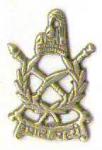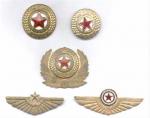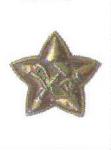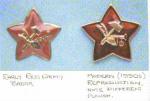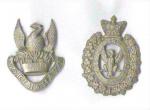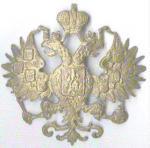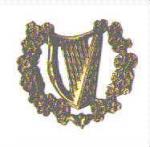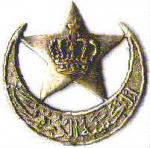
shako_uk
For Deletion-
Posts
90 -
Joined
-
Last visited
Content Type
Profiles
Forums
Blogs
Gallery
Events
Store
Everything posted by shako_uk
-
A few Nepalese badges shown below. Five only being identified. Can anyone tell me what No.4 is, please? All the badges (except No.4) are typical Indian-made cast brass items, but are finished with a coating of gloss black paint. No.4 is a die-struck badge with no fasteners. It looks to be a sew-on item. I would also be interested to hear if anyone has a cap badge of the Nepalese Air Force. 1. Ka Ba Battalion 2. Rajdal Battalion 3. Mahendra Dal Battalion 4. Unidentified 5. Pashupati Battalion 6. Sher Battalion I have a few more Nepalese badges, including a "set" of the officers' cap badges, if they are of interest. [attachmentid=54362]
-
Looks as though ithe buttons could be police items. The badge shown below is a police badge and has a similar design - crowned wreath enclosing kukri and baton. The badge is in cast brass of typical Indian manufacture, with integral split-pin lugs, 48mm high. What the extensions are, outside the wreath, I cannot imagine, but they obviously do not apply to the kukri. Hope this may add to your information (confusion?) Brian [attachmentid=53992]
-
Has anyone any information on the cap badges of North Korea? I have five badges, of which scans are shown below: The first is an Army officer's cockade, in gilt metal with red and white enamel centre, 37mm idia. This design of cockade was worn as far back as the Korean War. The second is a similar badge, but 32mm dia. The cockade I have previously seen, of this size, from the 1950s, was all gilt, with merely a red-painted star - most likely an other ranks' version? The third is a one-piece badge, 53mm across the wreath, the cockade being 32mm dia, as No.2. This seems to follow the Soviet pattern of badge, and is probably of later date than Nos. 1 and 2. The fourth badge is the wings emblem worn above the cockade by the Air Force. This is 62mm across the wing-tips. Is it worn by both officers and o/ranks? This badge, too, dates from, at least, the Korean War The fifth badge iis another wings emblem, presumably also worn above a cockade. But what is the difference between Nos 4 and 5? Is No.5 an officer's version of No.4 or is it, perhaps for a civil air line? If anyone can throw any light on these badges, I would be most grateful for their comments and, of course, if a North Korean Navy badge should be in your trades box, please let me know! Brian [attachmentid=45660]
-
a bunch of unknown items!
shako_uk replied to Christian L's topic in Rest of the World: Militaria & History
Hi Christian, Your last three badges are: No. 3 Yugoslavian Army officer's peaked cap badge No. 4 Yugoslavian Airforce officer's cap badge both from the communist period. No. 5 Serbia/Montenegro Army Other Ranks' beret badge (current) In view of the recent split between Serbia and Montenegro, this badge will probably change before long. Hope this information helps, Brian -
This is the "standard" Polish cap and beret badge during WW2. It was worn by all ranks fo the Army, though the Air Force nd Navy badges also incorporated this eagle. From about 1958, the crown was removed from the eagle, but since 1990 it has been reinstated. Brian
-
Soviet ww1? Soviet Cap Badge
shako_uk replied to Avitas's topic in USSR: Soviet Orders, Medals & Decorations
The red star badge, with hammer and sickle, was issued to the Red Army in 1922, worn by men, commissars and commanders. Prior to that the red star displayed a hammer and plough emblem, this being issued to the Workers and Peasants Red Army 1918. Scans of this badge are attached. The 'tired' badge is one that was given to me, years ago, by an old collector friend who, himself, had it from a Russian soldier in WW1. The badge itself is in good condition, complete with fasteners, but the red paint has suffered over the years. Purposely, I have not had this renovated. The star is 33mm high. The photograph shows another sample of the original badge, the property of another collector, plus a reproduction badge from about 1990. There are slight differences between the original and the copy. [attachmentid=42100] [attachmentid=42101] -
Badges Galore!
shako_uk replied to Ralph A's topic in Great Britain: Militaria: Badges, Uniforms & Equipment
Are the attached acans of any use, Kevin? I understand there is/was a two-piece version of the North Mayo, but I have never seen one. Brian [attachmentid=42027] -
Badges Galore!
shako_uk replied to Ralph A's topic in Great Britain: Militaria: Badges, Uniforms & Equipment
My Connaught Rangers badge is of similar design to yours, but with a different harp. It is also voided at both sides and top of the harp and also the harp strings at top right and lower left. The motto scroll fits closely onto the circle. Brian -
Badges Galore!
shako_uk replied to Ralph A's topic in Great Britain: Militaria: Badges, Uniforms & Equipment
Hi Kevin, Regarding the Tyneside Irish - unlike the Tyneside Scottish, they did not have a distinctive cap badge, but wore the normal Northumberland Fusiliers cap badge. The badge you illustrated is a shoulder badge, despite the fact the it is found with a slider. Brian -
Unknown Military Medical Insignia?
shako_uk replied to Kev in Deva's topic in Northern European & Baltic States
Sorry, Kevin, I cannot really help with values - as you know, much depends on how great is the buyer's need. The badge is relatively modern, and I would put it in the ?5-10 bracket. Regards, Brian -
Unknown Military Medical Insignia?
shako_uk replied to Kev in Deva's topic in Northern European & Baltic States
Hello, Kev, Regarding your query on the medical badge, it is certainly Italian. The mural crown is the one in current use, adopted after WW2, I think, as opposed to the Italian royal crown. Two scans attached, showing samples of one old badge and one current . The ring around the corps emblem was an addition and, prior to the introduction of the ringed badges, the emblem was worn alone. Possibly yours is one of the ealier versions, though I have not seen that method of fixing before. It is certainly a positive fastening and more secure than the sliders which are on many of the British badges. The ringed badge is 60mm high, the gilt metal one is 58mm high. Regards, Brian [attachmentid=40616] -
I have a small collecton of Malaysian badges, ranging from earlier badges of the Straits Settlements to the 1950s, but I gather that, of recent years, many of the Malaysian badges have been changed to incorporate changes of title, etc. The Malaysian authorities are not very helpful and I am seeking a source of the current Malaysian cap/beret badges so that I can up-date my collection. Suggestions will be appreciated. I have recently seen a few of these badges advertised on e-Bay, but the prices are in excess of what I am prepared to pay. However, it does show that there is a source somewhere. Brian
-
Continuation . . . Again, I cannot identify the black and white cockade, shown below. This is a porcelain badge , but, again, I so not think it is a military badge. The second badge is in silver and enamel and is probably an officer's cap badge, but what unit, I have no idea. In your posting on the Imperial Air force, you showed some pilot's badges and I was interested to see the similarity between these and the badge currently used on the cap by the modern Russian Air Force. Obviously, as with so many of their other present-day insignia, they have gone back to the old Imperial badges for their inspiration. The last badge shown on my scan is the secondary cap badge of the current Russian Air Force worn above the Army insignia, on peaked caps, by flying personnel. It replaced the Soviet pattern secondary badge which was merely a pair of wings. These badges are in anodised aluminium. [attachmentid=32003]
-
Hi George, I was very interested to read about your Crimean helmet plate (and to read some of your other postings on Imperial Russian items). I, too, have a 26th plate similar to yours, though the original number underneath the shield is 94. I also have another plate with a cut-out number 49, but this obviously lacks the add-on shield that should be there, since the attachment holes are also there. I have another helmet plate which is, I think, the pattern of 1857 which replaced the larger Crimean version, and was used up to 1917.. [attachmentid=31998] One or two more oddments from my collection follow, to complement your offering - hope they are of interest and comments will be welcomed. Cap badges from left to right: Army officers, Army N.C.Os., and Territorial Trops [attachmentid=31999] The next three are a little different . . . I do not know what the small one, on the left, is, but I think, probably not a military badge. The middle badge was worn by Finnish troops (Sharpshooters) in the Imperial Army and the badge on the right was worn on the breast. [attachmentid=32000] The final three are shown on the next posting, since there is not enough room on this one. t
-
Soviet Can anyone identify this star?
shako_uk replied to andy's topic in USSR: Soviet: Other Militaria
Andy, just confirming what has gone before, the red star is Yugoslavian, instituted not too long after WW2. after a short period when an oval cockade was used. It is an officer's cap badge, which came in two sizes, one (about 38mm across star points) was worn on the peaked cap, the other (30mm across star points) on the forage cap. Additionally, the badge came in two variations, one having the hammer and sickle emblem in the centre of the star, the other plain. The plain star versions were worn by regular troops, the hammer/sickle tpattern was used by special units derived from "proletarian" divisions and formations that had fought with distinction during WW2. Generals wore a similar badge, but with a full wreath around it. These badges were in use until about 1990, when the communist upheaval came about. Brian -
Beautiful Badges, but . . . ?
shako_uk replied to shako_uk's topic in Great Britain: Militaria: Badges, Uniforms & Equipment
Thank you very much for your comments, Graham, Jim, Keith - most enlightening! I had wondered if these badges were made for some promotional purpose, but I couldn't see anyone paying out for their manufacture, for they would not have been cheap to make. Only one of the badges has a maker's mark, that of J.R. Gaunt, on the slider. If indeed, the Frankilin Mint was responsible, then that would solve the problem, since, no doubt, they would charge accordingly. The main thing that comes out of this, I think, is that the badges are repros, albeit of a superior quality and should not be included in my collection. Thanks again, Brian -
Beautiful Badges, but . . . ?
shako_uk replied to shako_uk's topic in Great Britain: Militaria: Badges, Uniforms & Equipment
-
One of the reasons for the GMIC's existence is, I suppose, that it enables our queries to reach a wide audience of very knowledgeable enthusiasts and (hopefully) to get some useful answers. Having read many of the posts that have appeared over the past months, I am venturing another on a subject which has not cropped up before - though it may yet merge into the never-ending topic of fakes and restrikes. Some time ago, a neighbour presented me with 24 British badges which he said he had had for a number of years, but he did not recall how they had come into his possession. He was never a collector. All these badges are very well made and seem to have officer's quality finish. Six of these badges are shown in my scans: K.O.Y.L.I. - This badge has (I think) an oxidised silver finish, with a silver rose in the centre on a black enamelled background. The badge is 36mm wide with a slider at the back. EAST YORKSHIRE - In bright gilt finish, the central silver rose having a black enamelled backplate. again, a slider is fitted. 45mm across scroll WEST YORKSHIRE - In standard silver and gilt finishes, the scroll has a separate overlay. Slider at the rear, which, as with all these badges has been given a silver finish. It must have been finished before the scroll overlay was fitted. Standard size badge. SOUTH WALES BORDERERS - This badge has been die-struck in one piece, but ihas a silver, all-over finish, slider at the back and is smaller than normal, being 35mm across widest part. BEDS & HERTS - Similar in consttuction to the SWB, but with a black enamelled disc behind the hart. and, note, the size is only 32mm across the scroll. THE BUFFS - This is the standard pattern, but in a silver finish and with slider. 48mm at its widest point. Does anyone have any suggestions are to what these badges are. I have not seen their like previously. The sizes in some cases is not right, the sliders - on badges of this quality - are odd and some of the sizes are non-standard. The batch includes the Cameron Highlanders, Seaforths and the Cameronians (this last a small pattern) all equipped with sliders. The last three scans are on the continuation [attachmentid=29888] [attachmentid=29887]
-
Two more queries to test your knowledge (and add to mine!). Of the two scans attached, the first is a silver metal badge, 57mm across, with a vertical brooch-pin fastening. As can be seen, it has a Victorian crown. This came to me many years ago as a possible piper's badge of the Connaught Rangers. I have never pursued this to confirm the identification and would be interested to hear if anyone can verify it or otherwise christen the badge. The second badge is all brass, 38mm across, with officer-type blades horizontally placed. This badge was identified as "Republican 1916", but, again, has any Gentleman any further information to offer on this badge. It is unusual to have this type of fastening on a plain brass badge, but equally, does it make sense that an Irish Republican badge should be British made? Brian [attachmentid=28927][attachmentid=28928]
-
Help Wanted
shako_uk replied to shako_uk's topic in Great Britain: Militaria: Badges, Uniforms & Equipment
Tony, Hendrik, Peter, Ed. - thank you very much for your interest and comments. Yes, I have seen articles about the French Druze units and in a couple of them there was passing reference to the British Druze Cavalry and British Druze Regiment . What prompted my query, though, was the possession of a badge (acquired some few years ago) which I suspect may be a badge of this British unit. A scan of the badge is attached. It is cast in a silver metal, with a brass crown superimposed. The diameter across the crescent is 4.8mm and it has a horizontal brooch-pin fastening. The Arabic inscription reads: DRUZE SQUADRON, according to the Arabic Department at Leeds University. I suppose it could equally be interpreted as Druze Cavalry or Druze Regiment? I also have in my files, a photocopy picture of a British officer sporting this badge on his Arab head-dress, but there is no caption with the picture, though I understand that this particular officer lost his life in France, in 1944. I assume, that he had, by that time, returned to his Regiment. I will try to pursue this question further - there must be a record of this unit somewhare - and will let you know if I am successful. Thanks again. Brian [attachmentid=28921] -
Can any kind Gentleman give me any information on a unit called (variously) the British Druze Regiment, the Druze Cavalry or the Druze Squadron. Believed to have existed in the middle east during the early years of WW2, but apart from an odd passing reference to the unit, I have been able to find nothing else. With thanks in anticipation, Brian
-
I was interested to read Jan Arne's posting on the Norwegian Frontier Fighter badge, though, being a breast badge, it does not come within my collecting field. However, on the subject of cap badges, perhaps Jan Arne, or some other knowleable gentleman, can tell me something about the three badges shown below. All are cap badges, all Norwegian, I think. The first, on the left. is a peaked cap badge worn by the Norwegian Statspolitiet, known as "Stapo", raised in 1942 and under the command of the German gestapo. This badge is in oxidised silver and has a wing-span of 90mm. A smaller version was worn on the winter fur cap. The second badge belonged, I think to a German-raised organisation of Pioneers. Was it a military unit? From the similarity between this badge and those of the Norwegian Army of the time, it may have been. The third badge is somewhat of a mystery. It looks to me like the cap badge of "Quislings' Guard", but confirmation of this would be nice. I was under the impression that the badge should have a red centre, but maybe there were variations. This badge is in brass. Any comments would be appreciated. Brian [attachmentid=25765]
-
Thank you, Gentlemen, for your comment . . . most welcome The gilt badge, bottom centre could possibly be Congolese, I thought is could be African, myself, but have not seen anything like it before. It is nicely made, die-struck, in thin brass, 47mm high with a central screw fastening. No maker's name, but it has a "made in U.S.A." look about it. On the other hand, it is not as solidly made as the U.S. badges usually are. Mysteriously, it has a Latin motto "Vincit Amor Partriae and the initials HMR The two scans attached are added out of interest. These are both from Congo (Brazzaville) and are the first pattern Army vadge and the second pattern (the enamelled one) which I think is still in use. Belgian Congo/Zaire/ congo whatever it is now have entirely different badges, but nothing simillar to the one discussed above. The second badge, bottom right, is also die-struck, in brass, 53mm high, with spilit-pin loops N-S. I would guess it is British made, but I do not know a British badge of this design. Could be Naval, perhaps, or coast artillery and probably not a cap badge. Thanks again, Brian [attachmentid=18790]
-
You may be right, Rusty, but the fastening for the Airborne emblem cannot be seen, since it is sweated in place and, if there was a screw there, it has been filed off flush with the backplate. A further refinement, not visible on the scan, is that a needle projects from the tip of the pennant (just over an inch long). This slides into the material of the beret and keeps the pennant from coming away from the curve of the beret.





